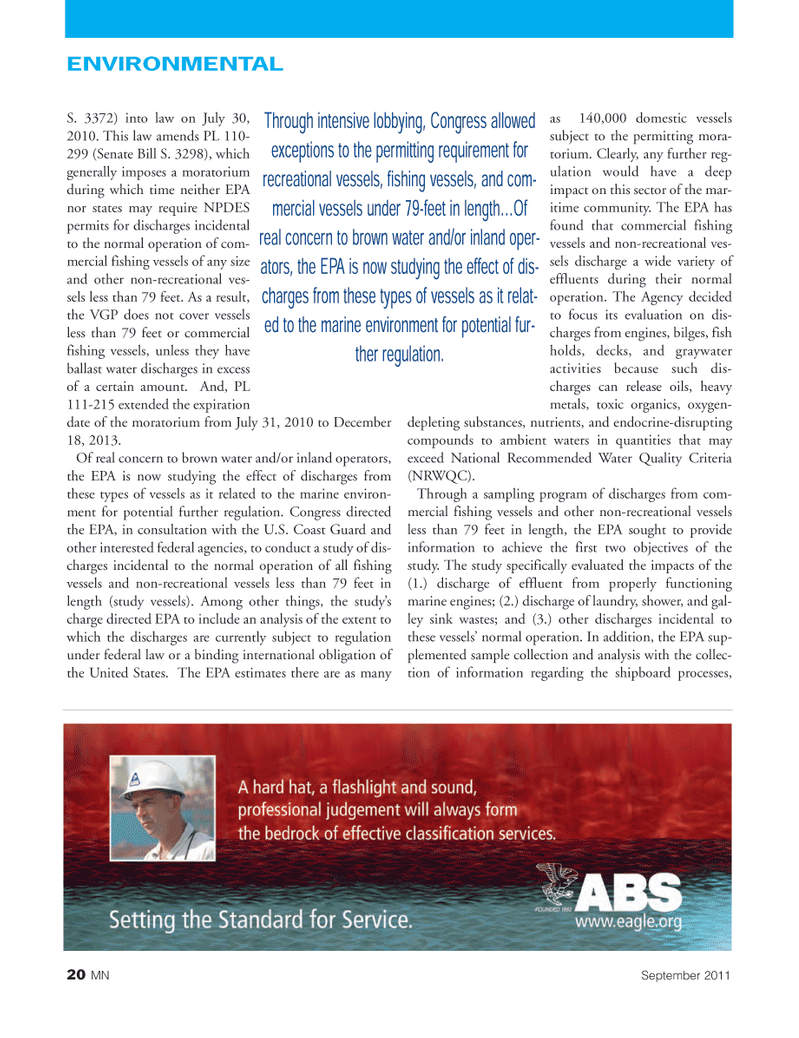
Page 20: of Marine News Magazine (September 2011)
The Environmental Edition
Read this page in Pdf, Flash or Html5 edition of September 2011 Marine News Magazine
20MNSeptember 2011ENVIRONMENTAL S. 3372) into law on July 30, 2010. This law amends PL 110- 299 (Senate Bill S. 3298), which generally imposes a moratoriumduring which time neither EPA nor states may require NPDES permits for discharges incidentalto the normal operation of com-mercial fishing vessels of any size and other non-recreational ves- sels less than 79 feet. As a result, the VGP does not cover vessels less than 79 feet or commercial fishing vessels, unless they have ballast water discharges in excess of a certain amount. And, PL 111-215 extended the expirationdate of the moratorium from July 31, 2010 to December 18, 2013. Of real concern to brown water and/or inland operators, the EPA is now studying the effect of discharges from these types of vessels as it related to the marine environ- ment for potential further regulation. Congress directed the EPA, in consultation with the U.S. Coast Guard and other interested federal agencies, to conduct a study of dis- charges incidental to the normal operation of all fishingvessels and non-recreational vessels less than 79 feet in length (study vessels). Among other things, the study?s charge directed EPA to include an analysis of the extent to which the discharges are currently subject to regulation under federal law or a binding international obligation ofthe United States. The EPA estimates there are as many as 140,000 domestic vessels subject to the permitting mora-torium. Clearly, any further reg- ulation would have a deep impact on this sector of the mar-itime community. The EPA has found that commercial fishing vessels and non-recreational ves- sels discharge a wide variety of effluents during their normaloperation. The Agency decided to focus its evaluation on dis- charges from engines, bilges, fish holds, decks, and graywateractivities because such dis-charges can release oils, heavy metals, toxic organics, oxygen- depleting substances, nutrients, and endocrine-disrupting compounds to ambient waters in quantities that mayexceed National Recommended Water Quality Criteria (NRWQC). Through a sampling program of discharges from com- mercial fishing vessels and other non-recreational vessels less than 79 feet in length, the EPA sought to provide information to achieve the first two objectives of the study. The study specifically evaluated the impacts of the (1.) discharge of effluent from properly functioning marine engines; (2.) discharge of laundry, shower, and gal- ley sink wastes; and (3.) other discharges incidental tothese vessels? normal operation. In addition, the EPA sup- plemented sample collection and analysis with the collec-tion of information regarding the shipboard processes, Through intensive lobbying, Congress allowed exceptions to the permitting requirement for recreational vessels, fishing vessels, and com- mercial vessels under 79-feet in length?Of real concern to brown water and/or inland oper- ators, the EPA is now studying the effect of dis- charges from these types of vessels as it relat- ed to the marine environment for potential fur- ther regulation.MN#9 (18-31):MN 2011 Layouts 9/6/2011 4:16 PM Page 20

 19
19

 21
21
